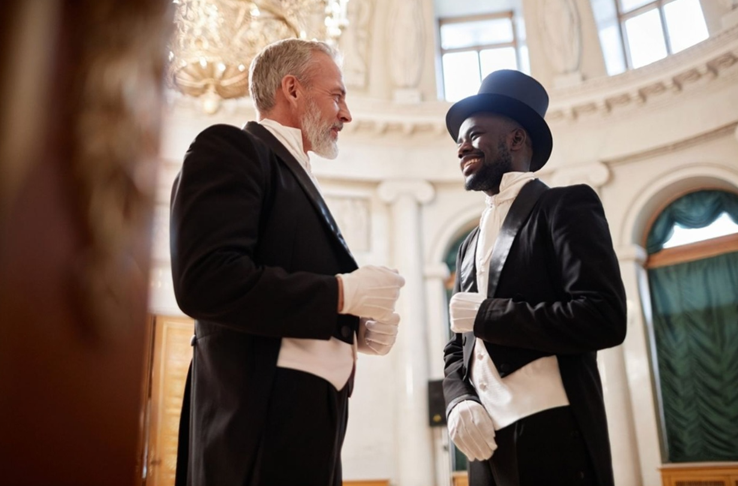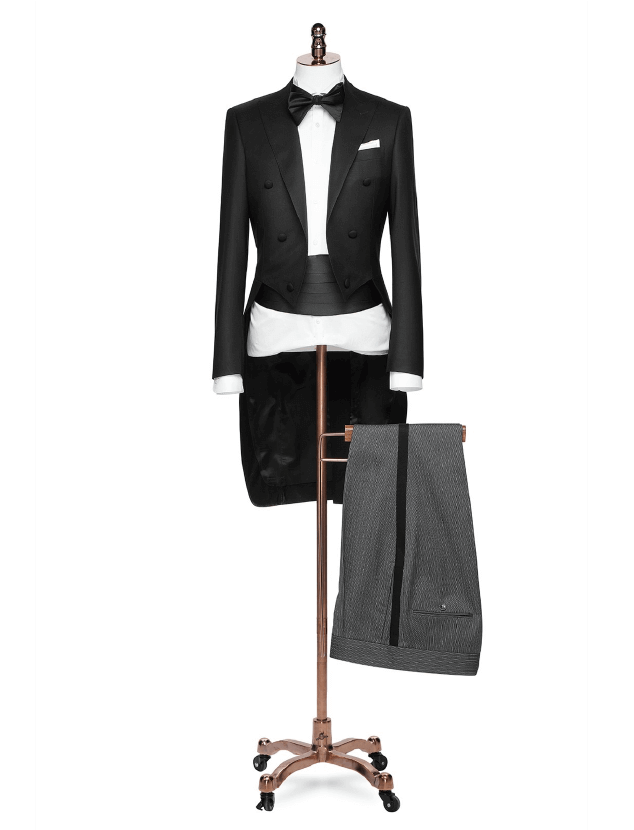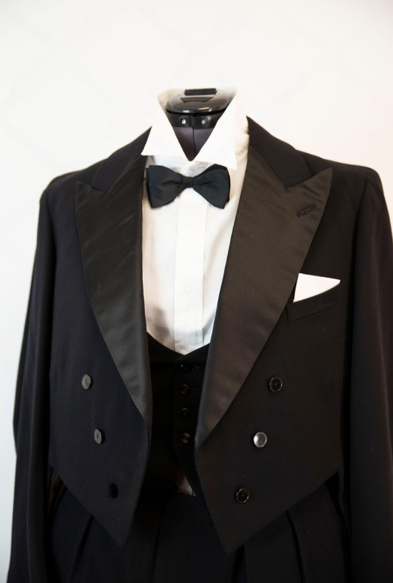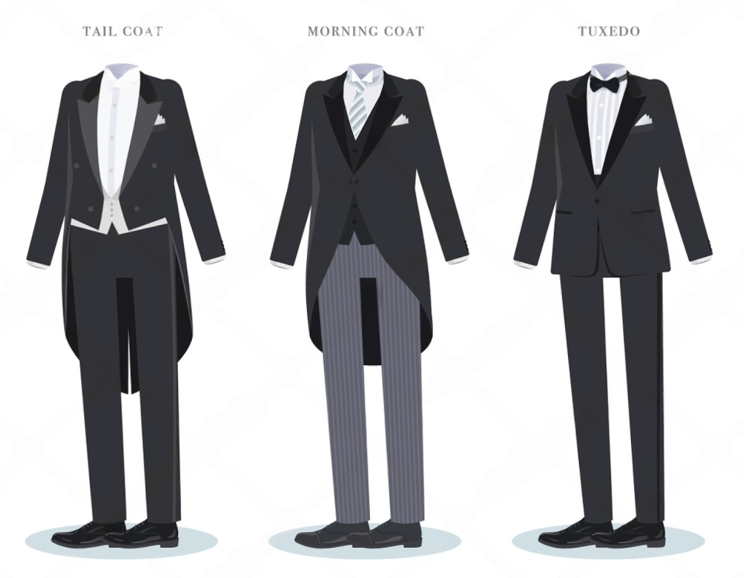
The tailcoat, one of the most formal garments a man can wear. You may have encountered the term “tailcoat” on an invitation to a white tie event, sparking curiosity about this attire. In modern society, tailcoats are seldom seen, and their strict dress code is known to few, leaving many puzzled about their role in contemporary fashion.
A tailcoat, also known as a dress coat, tuxedo tail, or full dress tail, is a knee-length, double-breasted jacket with a cut-away front and long tails at the back, designed solely for the white tie dress code—the most formal evening attire for men. Made from black or midnight blue wool (often barathea or mohair), it boasts silk-faced peaked lapels, a single center vent, and three non-functional buttons on each side. The tails, reaching the back of the knees, form the iconic “swallow-tail” silhouette, while the snug, unbuttoned fit highlights the torso.
Distinct from the morning coat (used in daytime morning dress) or equestrian shadbelly, the evening tailcoat is a hallmark of prestige. It is widely regarded as the king of all men's clothing.

The tailcoat traces its roots to the late 18th century, evolving from riding coats with fronts cut for horseback ease. Fashion pioneer George Brummell championed it as formal daywear, but by the 1850s, it became exclusive to white tie eveningwear, supplanting frock coats for daytime formality. The tuxedo (black tie) overtook it in the early 20th century, relegating the tailcoat to the most exclusive evening occasions, with rare daytime exceptions like European diplomatic ceremonies.
Today, the tailcoat shines at high-profile galas and formal banquets, its scarcity enhancing its allure as a symbol of enduring elegance.
The tailcoat is reserved for white tie events, held after 6 p.m. or sundown, as explicitly stated on invitations. These include:
· Grand balls, like those in historic European palaces.
· Formal state dinners or diplomatic receptions.
· Elite evening gatherings, such as cultural festivals or prestigious award ceremonies.
Daytime wear is rarely acceptable, permitted only when traveling to an evening event or for specific European state functions. The tailcoat is inappropriate for black tie, semi-formal, or casual settings like proms or office parties, where a tuxedo or suit is better suited.
Formality varies by region, with Europe upholding stricter white tie standards. In the U.S., formalwear is more flexible, but white tie remains a rare choice, making the tailcoat a striking statement.
Mastering the tailcoat requires precision, as the white tie ensemble is a harmonious blend of components. Here’s how to style it impeccably:
· Jacket: A black or midnight blue tailcoat with silk-faced peaked lapels, tailored for a snug, unbuttoned fit. The tails should reach the back of the knees.
· Trousers: High-waisted, matching the jacket, with double-braided satin stripes for polish.
· Waistcoat: White piqué, single-breasted with a shawl collar, ending above the tailcoat’s front points for clean lines.
· Shirt: White with a stiff, detachable wing collar and bib front, fastened with two or three studs.
· Bow Tie: White piqué, self-tied to reflect authenticity.
· Shoes: Patent leather opera pumps with grosgrain bows for tradition, or polished black oxfords for a modern touch.
· Socks: Long black silk socks for a seamless look.
· Optional: White gloves, a top hat, a white linen pocket square, a boutonnière, or a cane for historical flair.
A tailcoat demands custom formal wear or made-to-measure tailoring. The waistcoat and shirt must not extend below the tailcoat’s front, and the tails should align with the knees. A proper fit enhances posture and elegance.
· Choose black for tradition or midnight blue for a rich, modern hue under evening light.
· Avoid notch lapels, common in low-quality rentals, and ensure the bow tie suits your face’s proportions.
· Add a monogrammed shirt for a personal touch, ideal for significant events like weddings.

A tailcoat is suitable for a wedding only if the invitation specifies “white tie” and the ceremony or reception starts after 6 p.m., marking an ultra-formal evening event. These are rare, often high-profile weddings. Grooms or groomsmen may don tailcoats to complement a grand bridal vision, perhaps with a boutonnière for distinction.
For most weddings, a tailcoat is out of place. Daytime weddings or those requesting black tie or suits call for a tuxedo or formal suit. In the UK, evening weddings are uncommon, making white tie even less likely. In the U.S., some daytime weddings may misuse tailcoats due to relaxed norms, but this strays from tradition—always confirm with the couple.
· Check the dress code: Consult the couple or planner to avoid overdressing, which could clash with the event’s tone.
· Guest vs. Groom: As a guest, ensure your tailcoat doesn’t overshadow the groom. As a groom, coordinate with the bridal party, perhaps matching the bride’s gown with white tie elegance.
· Renting: For a one-time event, rent from trusted services, ensuring a tailored fit to avoid a boxy appearance.
· Comfort: Practice moving in the tailcoat—sitting, standing, dancing—to feel confident during the ceremony and reception.
A tailcoat at a white tie wedding is a bold, elegant choice, but it requires careful adherence to the event’s formality.
The tailcoat (white tie) and tuxedo (black tie) are distinct formal eveningwear options, often confused due to their refined looks. Here’s how they differ:
| Feature | Tailcoat (White Tie) | Tuxedo (Black Tie) |
| Formality | Highest level; for state dinners, grand balls | Less formal; suitable for galas, proms, weddings |
| Jacket Design | Long tails, cut-away front, silk-faced peaked lapels | Shorter length, satin lapels (peaked/shawl/notch) |
| Accessories | White piqué waistcoat, wing-collar shirt, white bow tie | Black cummerbund/waistcoat, pleated shirt, black bow tie |
| Shoes | Patent leather opera pumps | Patent leather oxfords or loafers |
| Occasions | Strictly white tie after 6 p.m., rare occasions | Common for black tie or optional events, including some daytime ones |
| Extra Items | Optional: Top hat, white gloves | Optional: Colored pocket square, modern cufflinks |

Check the invitation’s dress code to choose correctly. Tuxedos fit most modern formal events, while tailcoats shine in confirmed white tie settings.
The tailcoat is the epitome of men’s formalwear, perfect for white tie events like lavish evening weddings or grand balls, distinct from the more adaptable tuxedo. Its history, precise styling, and exclusivity make it a beacon of sophistication. Whether you’re stepping into a high-society wedding or a cultural gala, the tailcoat elevates any moment into timeless elegance. For broader formal occasions, a tuxedo may suffice, but the tailcoat awaits those ready to embrace tradition. If you’re sourcing high-end garments for clients or events, working with custom apparel suppliers ensures access to tailored pieces that meet white tie standards.